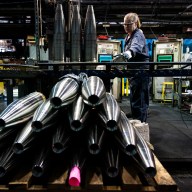By Lucia Mutikani
WASHINGTON (Reuters) – U.S. manufacturing activity eased in July amid shrinking order backlogs and declining employment, while an unexpected drop in construction spending in June suggested second-quarter economic was probably even weaker than reported last week. The Institute for Supply Management’s (ISM) report on Monday also showed manufacturers ramping up production to an 18-month high even as factories continued to draw down inventories, which some economists said pointed to moderate growth in the sector. Tim Quinlan, a senior economist at Wells Fargo Securities in Charlotte, North Carolina, said it was counterintuitive for manufacturers to step up production while cutting payrolls and running down inventories, given that production is a coincident indicator for the economy. “Perhaps the inventory drawdown has left stockrooms too spare, resulting in production increases as orders pick up,” Quinlan said. “These crosscurrents are explained somewhat by the fact that we are late in the economic cycle and businesses are understandably cautious with all the various risk factors.” ISM said its index of national factory activity slipped 0.6 percentage pointto a reading of 52.6 last month. A reading above 50 indicates an expansion in manufacturing, which accounts for about 12 percent of the U.S. economy. The index has now increased for five straight months. Manufacturers reported a moderate slowdown in new orders as well as export order growth. Order backlogs contracted as did factory employment and inventories, though the pace of destocking slowed. Manufacturers also reported that their customers continued to view inventories as too high. An outright drop in business inventories weighed on economic growth in the second quarter, with gross domestic product rising at a tepid 1.2 percent annualized rate after increasing at a 0.8 percent pace in the first quarter. Manufacturing remains constrained by the lagging effects of the dollar’s rally and an oil price plunge between June 2014 and December 2015, which have hurt exports and undercut business spending. With the dollar rising in recent months and oil prices slumping again, economists see little upside for manufacturing. ‘HAND-TO-MOUTH’ GROWTH
“Any growth in manufacturing is of the hand-to-mouth variety rather than a vibrant expansion,” said Michael Montgomery, U.S. economist at IHS Global Insight in Lexington, Massachusetts. “With the recent strength in the dollar still not fully reflected in imports and exports yet, we will need the data to be more convincing to call this anything more than almost stalled.” U.S. financial markets largely ignored the data. The S&P 500 index <.SPX> hit an intraday record high before falling into negative territory. Prices for U.S. government bonds fell, while the dollar <.DXY> rose against a basket of currencies. In a separate report, the Commerce Department said construction spending declined 0.6 percent to its lowest level since June 2015 after dipping 0.1 percent May. June marked the third straight month of declines in outlays. Economists polled by Reuters had forecast construction spending rising 0.5 percent in June after a previously reported0.8 percent drop in May. Their June estimates were largely based on the government’s assumptions for private residential and nonresidential construction spending in the advance GDP report. “The assumptions for June construction spending plugged into the advance GDP estimate were optimistic,” said Ted Wieseman, an economist at Morgan Stanley in New York.
“The government hasn’t released all of their assumptions yet, but these figures look consistent with second-quarter GDP growth being revised down to 1.1 percent or 1.0 percent.”
Weak spending on home building and nonresidential structures, including gas and oil well drilling, contributed to anemic growth in the last quarter.
In June, construction spending was held down by a 0.6percent drop in private construction. Outlays on private residential construction were unchanged as spending on both single-family and multi-family projects fell. Private residential construction spending edged up 0.1 percent in May. Spending on private nonresidential structures fell 1.3 percent in June, the biggest decline since December 2015, after rising 0.4 percent in May.
Public construction spending slipped 0.6 percent in June, dropping for a fourth straight month.
Outlays on state and local government construction projects, the largest portion of the public sector segment, fell 0.5 percent, the fourth consecutive monthly decline. Federal government construction spending dropped 2.3 percent in June. (Reporting by Lucia Mutikani; Editing by Paul Simao)
















